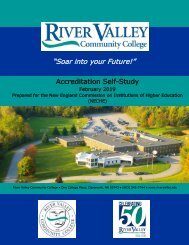Create successful ePaper yourself
Turn your PDF publications into a flip-book with our unique Google optimized e-Paper software.
to ensure students were provided study guides and homework assignments. Following<br />
these changes, exam scores increased and fell more in line with the other course sections.<br />
Another way in which these common assignments in A&P I and A&P II has been useful in<br />
assessing outcomes is by providing a way for the Program Director to recognize gaps in<br />
student knowledge. On the final case studies there is a set of expected answers. If there<br />
is an answer to a question that varies considerably from the expectations of the<br />
instructors, it provides a clue that there is a gap in teaching of particular content. In A&P<br />
II, reviewing problem areas on exams has led to improvements in teaching of specific<br />
concepts (blood typing and transfusions) as well as improving the way in which A&P I and<br />
A&P II concepts are related including: greater emphasis on second messenger systems<br />
and organic compounds; greater emphasis on cell respiration and organelle function;<br />
greater emphasis on hormones, and greater emphasis on adrenergic receptors and effects.<br />
The most widespread data collection that shows course outcomes are reflected in the data<br />
collected as part of the Math Co-Requisite Project described in Standard Five. Prior to<br />
implementation of the Co-Requisite Project, students in developmental math courses had<br />
only a 21% likelihood of passing a college-level mathematics course within two years. The<br />
pass rate for Spring 2018 was 94%. These results are significantly higher than the pass<br />
rates for students who begin in developmental mathematics, and are at or above the pass<br />
rates of students who meet the prerequisites for college-level mathematics.<br />
Most of the Allied Health programs including Nursing, as well as the Early Childhood<br />
Education and Social Science programs, have additional assessments of job readiness by<br />
requiring their students to participate in off-campus learning experiences. These clinical<br />
rotations, affiliations, practicums, internships and fieldworks provide direct, hands-on<br />
learning in the field of study. These courses are assessed through multiple avenues which<br />
include both direct observation of the student by <strong>RVCC</strong> faculty as well as via informal<br />
(phone or in-person conversations) and formal (completion of provided grading rubrics)<br />
assessments by the non-faculty professionals in the field who are hosting and supervising<br />
the <strong>RVCC</strong> students. Data related to outcome measures for these experiences is kept by<br />
each Clinical Coordinator or Program Director. For example, the Physical Therapist<br />
Director of Clinical Education provides a summation of the outcomes of the assessment<br />
tool completed by the Clinical Preceptors working with <strong>RVCC</strong> students to the other faculty<br />
in the PTA program upon completion of the clinical courses. For the Spring of 2018 cohort<br />
(senior level clinical affiliation), the expectation at the end is that the students are rated at<br />
“entry-level” meaning they are considered by their preceptor to be ready to step into clinic<br />
work with only minimal supervision. The DCE provided the following summation of student<br />
assessment: “All students were rated as entry level by their clinical instructor after their<br />
clinical affiliation. The number of patients seen varied greatly between settings and<br />
individual clinics. Some students saw a maximum of 5 patients a day and some saw 10.<br />
The complexity of the patients varied greatly among the settings as well. Overall, the<br />
clinicians supervising the students agree that they are entry level PTAs after their senior<br />
affiliation.”<br />
Many of the Allied Health programs have student learning outcomes related to professional<br />
behaviors. Professionalism in the Allied Health fields has been an area highlighted by<br />
advisory committees in recent years, and in response, programs have implemented course<br />
objectives or program objectives which are reflective of professional behaviors expected in<br />
125 | P a g e





